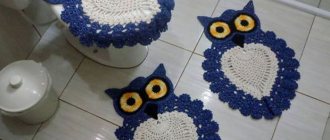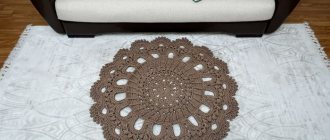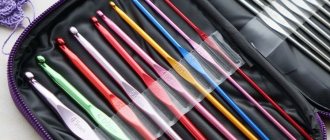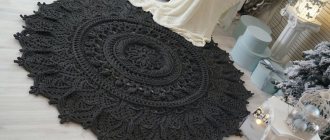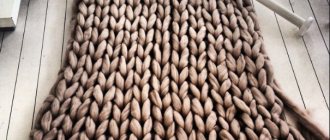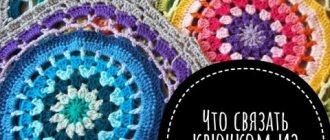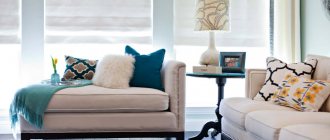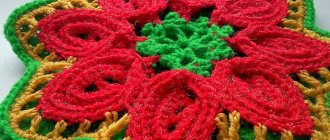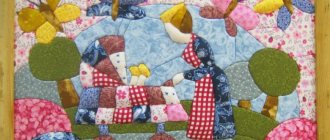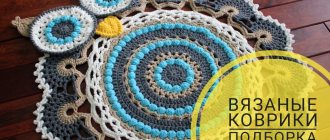About yarn
You should give several recommendations from experts in their field in choosing yarn. In order for the product to last a long time and retain its original appearance, you should give preference to synthetic types of yarn - this is the famous acrylic, but you can also use natural cotton (although it will not retain heat).
It is also necessary to clarify that for crocheting rugs it is better to use thicker threads - this will allow you to create a thicker fabric that is not inferior in retaining heat to standard fleecy products. For thick thread, hooks No. 5-8 are suitable. It is easy to determine the size of the fabric - it is recommended to knit a sample with a 10x10 cm square from the selected yarn, iron it or wash and dry it. The dimensions of the finished sample are measured and the required number of loops for further knitting is determined.
For knitting, you can use any napkin pattern - using your imagination will turn a simple pattern into an excellent design option.
Types of carpets
Carpeting is a fabric made from a single pattern, or combined from several individual elements. Napkin patterns are suitable for knitting, photos of which are published in abundance on handicraft Internet resources. Surprisingly, the only difference between a carpet and napkins is that a thick cord is used.
Models for Beginners
If previously your crocheting was limited to simple scarves or snoods, then you are recommended to start implementing a more useful item with a simple model. Several models of simple crocheted rugs with diagrams and descriptions are offered.
Square or rectangle
To begin with, it is recommended to use a simple mat shape - a square or rectangle. They can be knitted in a single fabric or using the knitting technique with motifs - the assembly of motifs determines the final result and design. The following selection of rugs and patterns for their implementation is given:
- A simple rectangular rug crocheted in single crochets in alternating colors. At the end, the fabric is simply tied with a series of single crochets, tassels are made from the same threads that were used for knitting. A track from the remains of yarn is knitted in a similar way - both melange threads and plain ones are used here. The paths look attractive in the hallways - right at the entrance, that homely and somewhat “country” comfort is created.
Rectangular crochet rugs can be created from simple squares of different colors, which are then simply sewn together with a needle. This is also an excellent product model for beginners, which even experienced knitters can use in the case of quick knitting.
- Rug crocheted with double crochets. Individuality and attractiveness are represented by changing colors in a diagonal and staircase sequence. Such products fit perfectly into children's rooms.
- Rugs with motifs using the “granny square” technique - these simple squares, with the replacement of threads of different colors, turn into unique and designer items when you show your imagination. To make crochet rugs using the presented technique, below is a knitting pattern.
For beginners, there are a huge number of models of rectangular or square products - it is only important to choose a model in accordance with the design of the room.
Round rugs
Round crochet rugs look great in bedrooms near beds. You can also implement a designer model for the kitchen - this is convenient for maintaining cleanliness in the room (you can wash products regularly without fear of fading and damage). Round rugs can be divided into two types - solid and openwork.
Solid round rugs are knitting a circle with a simpler pattern, resulting in a continuous and rational fabric for its intended use. Here you can also distinguish two subtypes - knitting with simple double crochets or knitting cones. It turns out two completely different options.
Simple fabrics with double crochets are represented by the following selection of products and patterns with descriptions.
Rugs with cones are more suitable for children's rooms, as well as living rooms, because they are textured and retain heat longer. The following selection of schemes is proposed.
Now we should talk about openwork rugs, which look more like an advantageous design solution. They are easy to implement if you have previously knitted openwork napkins and other similar products. To knit rugs, use the following patterns.
Oval rugs
Oval crocheted rugs are crocheted for elongated rooms, as well as for living rooms where coverage is needed in the seating area. For knitting, you can use the following selection of patterns.
From T-shirts
Knitted T-shirts often accumulate in huge quantities - it’s a shame to throw them away, but they are no longer suitable for further wear, or are simply tired of them. To get rid of the stock of knitted T-shirts, women's tunics and other things, you can resort to knitting rugs. To do this, old things are simply cut into thin strips and tied together into a long thread.
To crochet rugs from T-shirts, you can use any of the above patterns. In the absence of a large amount of household material, you can purchase a special knitting thread. Sometimes craftswomen simply purchase knitted fabric of a suitable color and cut it into thin strips - this creates an interesting and very economical design solution.
The following is a selection of designer T-shirt rugs, as well as detailed instructions on how to make a long thread from a small piece of fabric.
Japanese crochet rug
Japanese rugs only look complex in appearance, but upon careful analysis of the crochet technique, it turns out that this is the usual knitting of hollow circles that are connected in a certain sequence. For a simpler option, it is enough to use a model of 4 circles, which were later “filled” with a canvas of double crochets.
You can also resort to knitting such a carpet - a simple circle is crocheted in the middle, and then a chain of hollow circles characteristic of the Japanese motif is sewn to it, which in turn are connected to each other by a standard weave. Attaching the chain can be done with a needle and thread - it is only important to constantly try on the length of the chain to the initially specified middle circle.
Below is a selection of Japanese rugs, as well as patterns with a brief description of knitting - use your imagination and your product will be exquisite and suitable for the design of the room.
Rectangular carpet
For beginners, it is easier to make a rectangular carpet with your own hands. It looks no worse than round ones, in some cases even more interesting. Process content:
- Dial a chain of VP of the desired length;
- Knit all rows with sc, making three lifting loops at the end of the row.
You can knit the entire fabric with single crochets or alternate them. The edges of the product are left smooth or decorated using the picot technique or decorative decorations (fringe, pompoms) are sewn on.
Hand-crocheted carpets have a structure that compares favorably with store-bought ones, do not contain harmful substances, and are made from safe cotton cord. Housewives with knitting skills make carpets on their own, while others pay a lot of money for them.
https://youtu.be/pkV2PHVokaIhttps://youtu.be/tzMZ1q8UIIk
_
For experienced craftswomen
Experienced craftswomen can choose to crochet more complex patterns and variations, where most techniques use stitches that are difficult to knit. It is also worth noting the compatibility of complex patterns - pineapples are combined with cones, and cones with floral motifs, and so on. But you should still present several models for crocheting rugs yourself.
Rug based on the "Grand" napkin
You can easily make carpets from crocheted napkin patterns, and here, if necessary, you can increase the size of the future canvas by combining or “wedging” several rows with certain patterns. So the “Pineapple Song” napkin prompted experienced craftswomen to knit based on the existing pattern of the rug, called “Grand”. The new model fits perfectly into the interior design of Provence, Rococo, Baroque, Classicism, the more luxurious Gothic or Empire style. There is nothing complicated in knitting it - the main thing is to use the given patterns with descriptions:
- Cast on 8 chain stitches and close the chain into a ring. Next, continue knitting according to pattern 1. If necessary, you can increase the diameter by repeating the last few rows.
- Next, move on to knitting pattern 2 - here you can also increase the size of the carpet by adding a third row of petals above the pineapples.
- When finished, go to diagram 3 - this will allow you to finish the carpet smoothly and texturedly.
- For edging, pattern 4 is used, consisting of air loops and picot.
The presented model is recommended for independent execution in white, but if necessary, more attractive shades of thread that suit the color scheme of the room are also taken into account. The finished rug is simply soaked in cool water and laid out on a cloth, or directly on the floor until completely dry.
Pineapple openwork
Next, the rug in question becomes convenient for implementation by those craftswomen who cannot independently enlarge the diagrams to the required dimensions of the canvas. An openwork rug with additional pineapples can be knitted in two ways.
The first method involves starting knitting immediately according to pattern 2, where the required number of air loops is cast, but taking into account the proposed rapport. Further knitting is carried out according to the pattern without deviations.
The second method involves increasing the size of the rug - they begin to knit according to pattern 1 by the required amount, and only then move on to pattern 2, presented above. It turns out that openwork “fans” from a chain of air loops smoothly transition to double crochets in the middle part. In this way, you can “adjust” the dimensions of the finished canvas.
Simple but attractive blue lace
An openwork rug can be knitted using a simpler pattern - here it is only important to correctly arrange the petals from ordinary double crochets. So, it is proposed to use the following diagram, which will help to create a very attractive and versatile crochet rug model - change the shade, and you will get a completely different version of the fabric.
Rugs from bags
Rugs from bags are knitted using the same technique as from T-shirts and knitted fabrics. Here you will also need to cut long strips from bags and use a simpler pattern for crocheting a rug. It is not recommended to use an openwork pattern, because the joints of packet threads may become accessible to the public.
Of course, rugs made from bags are not used everywhere - they can be laid in the countryside, since such use will eliminate the hassle of cleaning the room from dirt and garden soil. But skilled needlewomen easily use bundled threads to knit a rug for the hallway of an apartment - it’s both convenient and stylish. Below is a full video of a master class on knitting a similar product.
Materials for knitting a carpet
The flooring can be made from any available materials. Old nylon stockings, knitted clothes cut into strips, threads from unraveled clothes, leftover yarn and even plastic bags are used.
All this variety of materials is suitable for knitting door and toilet mats, and bedding for pets. But if you have an idea to create a chic carpet worthy of the central place in the room, then only two types of cord will be useful:
- polyester;
- cotton.
Cord
Polyester cord is available in skeins of 200 meters. The color range includes more than 10 colors. There is a core inside that ensures quality. The core is additionally tied on both sides at the top. If there were no core, the product would stretch irreversibly. Many needlewomen fall for cheap cords, thinking that they are winning, but in the end they receive a low-quality product on which they spent time and put their hearts into it.
The thickness of the cord is 5 mm, it stretches slightly, and returns to its shape after stretching. Its structure is elastic, pleasant to the touch, and behaves well in use. Products made from polyester yarn can be washed in a washing machine at 30 degrees, but you cannot add fabric softener. The carpet dries quickly when flattened, does not deform, and holds its shape well.
After washing, all elements of the product remain expressive and clear, maintaining their properties for a long time. Polyester carpets do not absorb dust and do not harbor field mites. This is especially true for people and children suffering from dust allergies.
Cotton cord is sold as:
- unbleached;
- painted in colors.
Unbleached cotton cords are ideal for knitting openwork arches with a large arch. The elements are dense, hold their shape well and retain it after washing.
Cotton cord on sale looks like ordinary floss with thread. Before work, you need to wind it into a ball and knit from it. The material has a rich range of colors, the dusty beige color looks especially beautiful, natural, natural, fits into any interior. The cord also has a core.
European cotton cord is famous for its higher quality. Winding 50 meters and 100 meters. The good thing about unbleached cord is that it is packaged in a bag; there is no need to rewind it into a skein; just pull out the tip and knit, leaving the cord in the bag. This way it is reliably protected from contamination. The cord is very tight.
Hooks
Hooks are selected depending on the desired size of the carpet and yarn consumption. They mainly work with the following hooks:
- size 5 or 6;
- metal ones glide better and do not deform unlike plastic ones.
If you want to get a large carpet exceeding 2 meters in diameter, then hooks from size 7 to 9 are often used for work.
Anti-slip agent
A knitted rug is essentially a fabric cloth that tends to slide across the floor. This can result in injury from falling. If you look at the back surface of purchased carpets, you will see that they are rubberized. A man-made carpet must also be treated on the side that comes into contact with the floor. The following methods are suitable for this:
- treat with sealant or liquid rubber;
- attach rubber devices around the perimeter, which are sold in departments with creative goods;
- use a special mesh for carpeting, sold in rolls in hardware stores;
- use anti-vibration substrate for washing machines;
- For small rugs, the diameter of which does not exceed 1 meter, double-sided tape is suitable, but it does not last long, you need to constantly replace the sticky side.
In some articles on handicraft sites you can see an important note that silicone glue is not suitable for this task. When dry, it becomes hard and slides along with the mat, even more so.
Children's variations
Children prefer their own rooms with appropriate furnishings - everything should be bright and fabulous. Therefore, the task of parents is to take into account every little detail. If you previously did not take care of purchasing furniture or textiles for the children's room with appropriate prints, then today you can easily correct the situation:
- First, buy curtains with a child's pattern for your child's room.
- Secondly, replace the existing dark blanket on the bed with a bright children's option.
- Third, tie the rug! But not a simple one, but a special one - in the form of an animal.
Do you think knitting rugs in the shape of animals is a difficult task? Not at all - here only circles, ovals, squares, hexagons, rectangles and other individually connected figures are correctly assembled into a single composition
.
For example, you can see how to knit a simple rug in the shape of a bear:
- tie the bear's face - a simple circle of a suitable size in a gray shade;
- bear ears - 2 semicircles of white and gray;
- the bear's nose is a white circle, and the triangle is cut out of black suede (later it will be sewn on);
- bear cheeks – 2 circles of pink shade;
- eyelashes - 2 suede parts, which are also later sewn on in the designated places.
The rest of the children's rugs are knitted using the same principle - use your imagination and don't look for complications in the patterns! Everything ingenious is simple!
Bathroom rugs
A crocheted bath rug can be the key point of the entire design. Thus, a set of a rug in the toilet, in the bathroom, a “seat” for the toilet and an “organizer” for toilet paper can outshine expensive tiles or a super-functional bathroom. Moreover, similar knitted bath and toilet mats make an excellent housewarming gift. Below we offer the most interesting crocheted rugs for the bathroom and toilet.
Whale
A knitted bathroom rug can be made in the shape of a whale, which is knitted quite simply:
- Knitting begins in the round - this is the body of a whale.
- Having tied it to a suitable size, they begin to knit the tail, where the fins are simple and standard pineapple tying patterns.
- Next, you can begin tying the harness from half rows of fan-shaped repeats. It is better to do this even before knitting the tail - this will eliminate the need to constantly turn over the already bulky fabric.
- Finally, a fin is knitted - this is the same standard pineapple pattern.
Finish knitting the whale by knitting and attaching the eye, as well as the line of the waterfowl's mouth. You can separately give the whale a bow and splashes - let it be soft and cute.
Owls
A rather interesting option is a crocheted owl bath mat. Such products attract craftswomen with their extraordinary design, especially if a whole set is knitted, as well as ease of implementation. Here you should follow the following sequence:
- To begin, choose a more suitable pattern for knitting the owl's body - the body is knitted in the shape of a pineapple, where simple and standard patterns are used.
- Next, resort to tying the resulting pineapple to the required size of the rug or other part of the kit.
- Finally, the owl's eyes are knitted - these are two circles connected together in the last row. The connected eyes are tied, while the owl's ears are tied.
- All the parts are put together and you get an owl. It's easy to knit a knitted bath mat for an owl - a video with a detailed master class proves this unconditionally.
You can use a slightly different option for tying owls for the toilet and bathroom. A complete knitting pattern is also provided.
For knitting rugs for the bathroom and toilet, it is better to use natural types of yarn. Adding synthetic materials can cause the rug to slide on your bathroom tiles. The same fact does not allow you to create a bathroom rug using a crochet hook made from bags - it is dangerous.
Below is a selection of sets of crocheted rugs for the bathroom and toilet - simpler variations for beginners and experienced ones. Simple diagrams contribute to the formation of a masterpiece.
Crocheted rugs are not only simple and beautiful, but also stylish, fashionable, enchanting! Yes, yes, all the invited guests will be delighted - after all, it’s not always possible to see a lace fabric on the floor. And if the rug is a decorative element, then be prepared for it to take on all the admiring glances and dominant notes.
But I don’t say goodbye to you at this point, come back again, and I sincerely wish you creative success!
